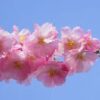**Cherry Blossoms and the Economic Development of Japan**

Cherry blossoms, or “sakura” in Japanese, have played a significant role in the economic development and cultural identity of Japan. Here, we explore how the presence of cherry blossoms has contributed to Japan’s economic growth and societal prosperity:
1. **Tourism and Hospitality:** Cherry blossom season, known as “hanami,” attracts millions of visitors to Japan each year, fueling the country’s tourism industry. Travelers from around the world flock to iconic cherry blossom viewing spots such as Tokyo’s Ueno Park, Kyoto’s Philosopher’s Path, and the Hirosaki Castle in Aomori Prefecture. This influx of tourists boosts revenue for hotels, restaurants, transportation services, and local businesses, stimulating economic activity across various sectors.
2. **Cultural Exports:** Cherry blossoms serve as powerful symbols of Japanese culture and aesthetics, contributing to the global popularity of Japanese products and exports. From traditional arts such as ukiyo-e prints and kimono textiles to modern cultural exports like anime, manga, and electronic gadgets, the allure of cherry blossoms is often incorporated into Japanese products and designs, enhancing their appeal in international markets. This cultural resonance helps drive demand for Japanese goods and fosters Japan’s soft power diplomacy on the global stage.
3. **Regional Development:** Cherry blossom festivals and events contribute to the economic revitalization of rural areas and local communities across Japan. In regions such as Fukushima, Tohoku, and Hokkaido, cherry blossom festivals attract tourists and stimulate economic growth in areas that may otherwise face economic challenges. Local governments invest in infrastructure, promotion, and hospitality services to capitalize on the economic opportunities presented by cherry blossom tourism, supporting sustainable development and job creation in rural areas.
4. **Retail and Merchandising:** The imagery of cherry blossoms is ubiquitous in Japanese retail and merchandising, driving consumer spending on a wide range of products. From sakura-themed snacks and beverages to cosmetics, fashion accessories, and stationery, cherry blossom motifs are popular among Japanese consumers and tourists alike. Retailers capitalize on the seasonal appeal of cherry blossoms by launching limited-edition products and marketing campaigns, driving sales and enhancing brand loyalty.
5. **Corporate Sponsorship and Branding:** Cherry blossom festivals and events often attract corporate sponsorship from leading Japanese companies seeking to enhance their brand image and connect with consumers. Companies sponsor cherry blossom viewing parties, cultural exhibitions, and philanthropic initiatives, leveraging the symbolic resonance of cherry blossoms to strengthen their corporate identity and social responsibility efforts. This corporate investment in cherry blossom-related activities further contributes to the economic vitality and cultural vibrancy of Japan.
In summary, cherry blossoms play a pivotal role in Japan’s economic development, tourism industry, cultural exports, regional revitalization, and retail sector. As enduring symbols of natural beauty and cultural heritage, cherry blossoms continue to drive economic growth and foster a sense of national pride and identity in Japan.
**Part 2: Cherry Blossoms and Economic Impact in Japan**
Beyond their cultural significance, cherry blossoms have a tangible economic impact on various sectors in Japan. Here’s a closer look at how these iconic flowers contribute to the country’s economic development:
1. **Cherry Blossom Tourism:** The cherry blossom season attracts a significant number of domestic and international tourists to Japan, boosting the tourism industry. Tourists come to experience hanami, or cherry blossom viewing, at popular spots like Tokyo’s Chidorigafuchi Park and Kyoto’s Maruyama Park. This influx of visitors stimulates spending on accommodations, dining, transportation, souvenirs, and other travel-related services, generating revenue for local businesses and supporting employment in the tourism sector.
2. **Hospitality and Accommodation:** During the cherry blossom season, hotels and ryokans (traditional Japanese inns) experience high occupancy rates, particularly in cities renowned for their cherry blossoms. Hoteliers capitalize on this demand by offering special hanami packages and organizing viewing events for guests. The increased demand for accommodation drives up room rates and provides a significant revenue stream for the hospitality industry.
3. **Retail and Merchandising:** Cherry blossom-themed merchandise experiences a surge in sales leading up to and during the hanami season. Retailers stock shelves with a wide array of products featuring cherry blossom motifs, including clothing, accessories, home decor, and food items. Tourists and locals alike eagerly purchase these souvenirs and gifts as mementos of their hanami experience, contributing to retail sales growth and stimulating consumer spending.
4. **Transportation and Infrastructure:** Transportation services, including airlines, railways, and buses, experience heightened demand during the cherry blossom season as travelers move between cities and regions to view the blooms. Rail companies often offer special hanami train packages, while bus operators organize cherry blossom sightseeing tours. Additionally, local governments invest in maintaining and beautifying public parks and gardens where cherry blossoms bloom, enhancing the overall visitor experience and supporting infrastructure development.
5. **Corporate Sponsorship and Events:** Cherry blossom festivals and events receive sponsorship from corporate entities seeking to enhance their brand visibility and engage with consumers. Major corporations sponsor hanami parties, cultural performances, and art exhibitions, leveraging these opportunities for marketing and promotion. Corporate involvement in cherry blossom-related activities not only provides financial support for event organizers but also fosters community engagement and social cohesion.
6. **Real Estate and Property Development:** Properties located near popular cherry blossom viewing spots often command higher prices and attract real estate investment. Residential neighborhoods and commercial districts with abundant cherry trees are seen as desirable locations, driving demand for housing and commercial spaces. Property developers may incorporate cherry blossom gardens and green spaces into their projects to enhance their appeal to potential buyers and tenants.
In conclusion, the economic impact of cherry blossoms in Japan extends across multiple sectors, including tourism, hospitality, retail, transportation, real estate, and corporate sponsorship. As a symbol of natural beauty and cultural heritage, cherry blossoms not only attract visitors and drive consumer spending but also contribute to the overall prosperity and vitality of Japan’s economy.

